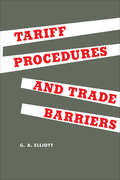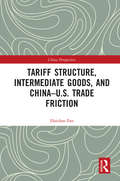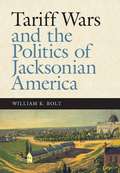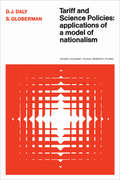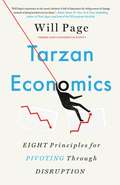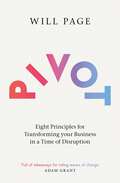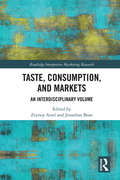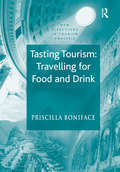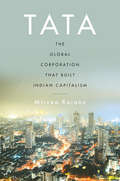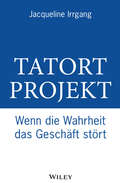- Table View
- List View
Targets: Picking Your Spots for Analytics--How to Apply Analytics Where They Will Yield the Greatest Results
by Thomas H. Davenport Jeanne G. Harris Robert MorisonEvery business can benefit from becoming more analytical across the board--in how it understands its customers, performs its operations, and makes decisions. But even the most analytically oriented company needs to target its analytical efforts where they will do the most good, because resources--especially talent--are always constrained. In this chapter, the authors of the game-changing book Competing on Analytics guide you through choosing your targeted areas for analytics. They show you how to analyze both your organization's strategic plan as well as industry trends, set appropriate goals, and prioritize your best targets. The chapter includes tools and techniques that will help you to thoroughly and purposefully weigh your opportunities and move your organization toward becoming a more analytical competitor. This chapter was originally published as Chapter 5 of Analytics at Work: Smarter Decisions, Better Results.
Tariff Determination in the General Equilibrium of a Political Economy: A Bargain-theoretic Approach to Policy Modelling (Routledge Revivals)
by Hom Moorti PantFirst published in 1997, this volume builds an economic model in which a model of the policy-formation process was grafted onto an economic model of the traditional kind. Politics are not made in a vacuum; they have their basis in the politico-economic system which economists have been modelling and analysing for a very long time. For economists, government policies are particularly important as they determine the environment within which all agents make their choices and the way in which the market allocates resources. Through an examination of tariffs and an equilibrium model of the economic sphere of a small open political economy, Hom Moorti Pant aims to explore some of the reasons and effects of government policy decisions on the economy.
Tariff Levels and the Economic Unity of Europe: An Examination of Tariff Policy, Export Movements and the Economic Integration of Europe, 1913-1931 (Routledge Library Editions: International Trade Policy #25)
by H. LiepmannThe years between the Wars saw rapid and far-reaching changes to the character and distribution of the world’s trade. Governments of the world attempted to mould and control their own economies, and economic nationalism grew to unseen levels. This book, first published in 1938, is the comprehensive examination of the European tariffs of the time, and it traces their effects upon the actual course of trade, and in so doing, is one of the few factual studies on the reality of tariffs.
Tariff Procedures and Trade Barriers: A Study of Indirect Protection in Canada and the United States
by George ElliottMost Canadians are vividly aware of some of the effects tariffs have on their daily lives. As consumers they pay more than their American neighbours for many articles in everyday use; as producers they often find their markets drastically restricted because of tariff barriers. Indeed, the customs tariff has been a burning issue in the political and economic life of the country for most of its history. It is always a current topic of discussion, in ordinary conversation, in newspapers and periodicals, in scholarly studies, and in surveys and reports by government and industry. But while Canadians, as consumers and producers, have personal experience and a general knowledge of the rates of duty explicitly stated in the customs tariff and knowingly ratified by the legislators and the public, they are not so well informed about another set of costs which, like the duties, have to be borne by importers and exporters, and ultimately by consumers and producers. These are the costs of administration, not only of the tariff, but also of other regulations designed primarily to preserve health or to prevent fraud or the infringement of patents. Certain costs of this nature are inevitable, and the delays, uncertainties, and expense they cause to exporters and importers, though not so readily apparent to the public, are nevertheless as much a part of the obstacle to trade as are the stated rates of duty. A more serious aspect of procedures for collecting customs and enforcing regulations, however, is the fact that they may confer an inordinate degree of protection on certain domestic producers, either unintentionally through inept regulations or administrative inefficiency, or intentionally by regulations designed to discriminate unobtrusively against imported merchandise. But whether they are part of the necessary cost of collection and enforcement, or unintended expenses resulting from inadvertence, or calculated burdens imposed by stealth, they all confer a greater measure of protection on the domestic consumer than has been proved by the electorate. This additional, 'indirect' protection is the subject of Professor Elliott's interesting and informative study. By a clear and orderly marshalling of the facts, and a wealth of illustrative cases, he has furnished a picture of the burden imposed on the economic life of the country and the obstacles put in the way of international trade by 'procedures.' In so doing he has provided a background of information against which the total effects of tariffs and import regulations may be assessed. It is in the interests of all that the customs tariff, like any other tax, should be designed to secure its objectives as efficiently as possible. A good customs tariff, like a good tax system, should conform to the four canons of taxation laid down long ago by Adam Smith: it should provide equity, certainty, convenience, and economy. This book is intended not as a customs manual for importers and exporters, but as a source of information and enlightenment for that alert and critical public whose interest in international economic relations and constant awareness of facts have already provided a strong impetus to a world movement in favour of more liberal trade policies. Professor Elliott's book is published under the auspices of the Canadian Institute of International Affairs and the Canadian Tax Foundation.
Tariff Structure, Intermediate Goods, and China–U.S. Trade Friction (China Perspectives)
by Haichao FanFocusing on the interconnection of tariff structure, international trade and welfare evaluation, the book investigates the characteristics of tariff structures of China and the U.S. in recent years and measures the impact of the Sino–U.S. trade friction that started in 2018. The first part of the book discusses levels and evolution trends of tariff systems of China and the U.S. from 2000 to 2014 and makes a comparison between the two countries' tariff structures. The second part centers on the Sino–U.S. trade friction in 2018, analyzing its development, overall impact on welfare, and relevant impact mechanisms. The author draws on the quantitative analysis method currently prevailing in the field of international trade, taking global value chains, intermediate goods, and variable markup into consideration. In contrast to the research conclusion applying standard trade theory, the result indicates that either unilateral imposition of additional tariffs or bilateral tariff friction will give rise to the deteriorated welfare level of both countries. The book will appeal to academics and policy makers interested in international trade, China–U.S. relation and the trade friction.
Tariff Wars and the Politics of Jacksonian America (New Perspectives on Jacksonian America)
by William K. BoltBefore the Civil War, the American people did not have to worry about a federal tax collector coming to their door. The reason why was the tariff, taxing foreign goods and imports on arrival in the United States. Tariff Wars and the Politics of Jacksonian America attempts to show why the tariff was an important part of the national narrative in the antebellum period. The debates in Congress over the tariff were acrimonious, with pitched arguments between politicians, interest groups, newspapers, and a broader electorate.The spreading of democracy caused by the tariff evoked bitter sectional controversy among Americans. Northerners claimed they needed a tariff to protect their industries and also their wages. Southerners alleged the tariff forced them to buy goods at increased prices. Having lost the argument against the tariff on its merits, in the 1820s, southerners began to argue the Constitution did not allow Congress to enact a protective tariff. In this fight, we see increased tensions between northerners and southerners in the decades before the Civil War began.As Tariff Wars reveals, this struggle spawned a controversy that placed the nation on a path that would lead to the early morning hours of Charleston Harbor in April of 1861.
Tariff Wars and the Politics of Jacksonian America (New Perspectives on Jacksonian America)
by William K. BoltBefore the Civil War, the American people did not have to worry about a federal tax collector coming to their door. The reason why was the tariff, taxing foreign goods and imports on arrival in the United States. Tariff Wars and the Politics of Jacksonian America attempts to show why the tariff was an important part of the national narrative in the antebellum period. The debates in Congress over the tariff were acrimonious, with pitched arguments between politicians, interest groups, newspapers, and a broader electorate. The spreading of democracy caused by the tariff evoked bitter sectional controversy among Americans. Northerners claimed they needed a tariff to protect their industries and also their wages. Southerners alleged the tariff forced them to buy goods at increased prices. Having lost the argument against the tariff on its merits, in the 1820s, southerners began to argue the Constitution did not allow Congress to enact a protective tariff. In this fight, we see increased tensions between northerners and southerners in the decades before the Civil War began. As Tariff Wars reveals, this struggle spawned a controversy that placed the nation on a path that would lead to the early morning hours of Charleston Harbor in April of 1861.
Tariff and Science Policies: Applications of a Model of Nationalism
by D. J. Daly S. GlobermanThis controversial analysis of economic nationalism will interest economists and those concerned with nationalism and the competitive position of Canadian manufacturing. It is the first attempt to test empirically an economic model of nationalism, a model which implies than an emphasis on nationalism ultimately reduces economic efficiency – with low-income groups bearing most of the resultant cost – and redistributes income from lower – to upper-income individuals. Applying the model to federal commercial and science policies, the authors argue that these policies have contributed to the high costs and low productivity of Canadian manufacturing and retarded the adoption of new processes and improved techniques. They find that the costs of these are borne by the urban workers and the consumer, while the major beneficiaries are Canadian managers, scientists, and engineers. The efficiency and competitive position of Canadian industry are reduced and income redistributed from lower- to upper-income groups. Science policies designed to increase, at high cost, a broad range of Canadian research and development capabilities are related to the slower adoption of new manufacturing processes in Canada than in the United States and Europe. The authors conclude that greater trade liberalization and increased industrial specialization would benefit Canada and Ontario, that more emphasis should be placed on rapid diffusion of innovation, and that research should be concentrated in fields where Canada has a potential competitive advantage.
Tarnished: Toxic Leadership in the U.S. Military
by George E. ReedBad or toxic leadership, abusive supervision, and petty tyranny in organizations are perennial issues. But to date, there has been little effort to examine the scope and nature of bad leadership in the military. Tarnished rectifies that lack of attention by defining the problems and suggesting possible solutions appropriate to the military’s unique structure and situation. Leadership is central to the identity of the U.S. military. Service academies and precommissioning processes have traditionally stressed the development of conscientious leaders of character. The services regularly publish doctrinal works and professional journal articles focusing on various aspects of leadership. Unsurprisingly, in most of those publications leadership is presented as a universally positive notion, a solution to problems, and something to be developed through an extensive and costly system of professional military education. Leadership expert George E. Reed, however, focuses on individual experiences of toxic leadership at the organizational level, arguing that because toxic leadership has such a detrimental impact on the military organizational culture, additional remediation measures are needed. Reed also demonstrates how system dynamics and military culture themselves contribute to the problem. Most significant, the book provides cogent advice and insights to those suffering from toxic leaders, educators developing tomorrow’s military leaders, and military administrators working to repair the current system.
Tarzan Economics: Eight Principles for Pivoting Through Disruption
by Will PageTaking the lessons learned from his years studying the rise and fall of the modern music industry, Spotify's Chief Economist has crafted &“a compelling and generous read&” (Scott Galloway) that provides the tools to recognize and adapt to disruption in any industry. As the chief economist at Spotify, Will Page has had the best seat in the house for witnessing—and harnessing—the power of disruptive change. Music has often been the canary in the coal mine for major technological and societal shifts, and if there&’s one thing Page learned from the digital revolution, it&’s that businesses must be ready to pivot.Drawing practical lessons from a variety of fresh case studies covering Radiohead, Starbucks, and even Groucho Marx, Page examines the eight principles that disruption has thrown into sharp relief as keys to survival in any sector. Businesses need to be ready and willing to change and, if necessary, be prepared to rebuild entire organizations and business models to do so. Pivoting through disruption has everything to do with being able to see the revolutionary changes around the corner, recognizing your strengths, and having the confidence to let go of the old vine of doing business and grab onto the new. A rare book of economics offering actionable takeaways in easy-to-understand language, Tarzan Economics is the must-read book for anyone staring at their own Napster moment and wishing they knew how to fail-safe their business.
Tarzan Economics: Eight Principles for Pivoting through Disruption
by Will PageA stunning new insight into how the most crucial lesson you can learn in today&’s challenging business environment is how to change the fundamentals of what you do, rather than carry on fighting a battle that is already lost. The near destruction of the music industry at the hands of online piracy and its subsequent recovery on the backs of digital streaming platforms is more than just the biggest story of disruption and reinvention of the digital age. It is also a trove of insights on how to confront the metamorphosis we are all facing in dealing with the Covid-19 era, as accelerating tech and economic changes reshape our work, our play and our very minds. Will Page, Spotify&’s first chief economist, extrapolates music&’s journey into eight guiding principles for pivoting through the ubiquitous disruption in nearly all industries. Expect the unexpected with transferable lessons coming from Starbucks, Tupperware and even Groucho Marx. The notion of 'Tarzan Economics' ties these principles together: a framework for recognising and acting on disruption, by letting go of the old vine and grabbing onto the new. Page joyfully brings these insights to life and provides a guide for knowing not just how to grab the new vine, but when. He assesses the new dynamics of the 'long tail', identifies friends and foes in the battle for scarce attention and provides a practical tool for discovering the right role for each of us to succeed in this new modern world.As we emerge from the unprecedented disruption of a global pandemic, Tarzan Economics shows all of us - individuals, organisations and institutions - that if the vine we are holding onto is withering, we can have confidence to reach out for a new one in 2021 and beyond.
Taste of Frankenmuth: A Town in Michigan Thinks About Word-of-Mouth Referral
by Abby Hansen Roger HallowellA town, "Michigan's little Bavaria," discusses word-of-mouth referral. Enables students to calculate the value of word-of-mouth and understand how to increase it.
Taste, Consumption and Markets: An Interdisciplinary Volume (Routledge Interpretive Marketing Research)
by Jonathan Bean Zeynep ArselTaste is a core concept for the social sciences and an orienting notion in everyday practice. It is of equal relevance to academics and laypeople alike. Theorizations of taste are frequently multi- disciplinary, bringing an opportunity to cross-fertilize ideas and concepts. At the same time, a reader, challenged by the diverse body and dispersed nature of theories on taste, needs guidance navigating the literature and framing areas of interest. Until now, those interested in an academic perspective on the concept have had to traverse a wide range of literature. This is the first book that assembles a range of writings on taste from across disciplines to provide the reader with a sense of the emerging and expanding boundaries of this field of study. Taste, Consumption and Markets offers a comprehensive and up-to-date review of taste, with an emphasis on how taste shapes boundaries, subcultures, and global culture, complemented by an introduction that provides a scaffold for the reader and a concluding section that reflects on the past, present, and future of research on taste. It shows the latest state of knowledge on the topic and will be of interest to students at an advanced level, academics, and reflective practitioners. It addresses the topics with regard to the sociology of taste and consumption and will be of interest to researchers, academics, and students in the fields of consumer studies, consumption ethics, sociological perspectives on consumption, and cultural studies.
Tasting Tourism: Travelling for Food and Drink (New Directions in Tourism Analysis)
by Priscilla BonifaceAlong with basic practical reasons, our practices concerning food and drink are driven by context and environment, belief and convention, aspiration and desire to display - in short, by culture. Similarly, culture guides how tourism is used and operates. This book examines food and drink tourism, as it is now and is likely to develop, through a cultural 'lens'. It asks: what is food and drink tourism, and why have food and drink provisions and information points become tourist destinations in their own right, rather than remaining among a number of tourism features and components? While it offers a range of international examples, the main focus is on food and drink tourism in the UK. What with the current diversification of tourism in rural areas, the increased popularity of this type of tourism in the UK, the series of BSE, vCJD and foot and mouth crises in British food production, and the cultural and ethnic fusion in British towns and cities, it makes a particularly rich place in which to explore this subject. The author concludes that the future of food and drink tourism lies in diversity and distinctiveness. In an era of globalisation, there is a particular desire to enjoy varied, rather than mono-cultural ambiance and experience. She also notes that there is an immediacy of gratification in food and drink consumption which has become a general requirement of contemporary society.
Tata Consultancy Services
by Rohit Deshpande Seth SchulmanAs CEO of Tata Consultancy Services (TCS), S. "Ram" Ramadorai had grown the company into an emerging IT services powerhouse, with marquee clients such as General Electric, offices in 32 countries, and revenues of nearly $2 billion dollars. Now, he was about to steer TCS through an initial public offering--the largest ever by a private Indian company. Despite his excitement, Ramadorai knew that in some ways the timing of the IPO was not ideal. TCS had profited tremendously from corporate America's willingness to outsource IT and business process functions to overseas providers. But outsourcing had recently come under attack, with some politicians and labor leaders denouncing it as a threat to American jobs and America's economic dominance. In addition, TCS was facing rising labor costs in India and competition from emerging IT industries in East Asia, South America, and elsewhere. How would Ramadorai address these issues to ease investors' concerns on the eve of the IPO?
Tata Consultancy Services Iberoamerica
by Gustavo A. Herrero Michael ChuTo launch its Latin American operations, the Indian IT giant Tata Consultancy Services recruits a seasoned executive who becomes the only non-Indian member of senior management. Reviews the start-up operations, from the site selection to staffing and training, the challenges of operating in a Latin American context, the integration of two very different cultures, and the strategic rationale for an emerging market company to invest in another Third World region at a time in which it is launching an initial public offering. Identifies a series of challenges that must be addressed two years on and poses the question whether Tata Consultancy Services should pause or accelerate its presence in Latin America.
Tata Group in 2021: Pursuing Profits through Purpose
by Tarun Khanna Krishna G. Palepu Vidhya MuthuramOctober 8, 2021: Tata Sons won a bid to acquire India's national carrier Air India, marking the airline's return to its original owners after 68 long years. The winning bid of $2.4 billion gave Tata Sons full ownership of the airline and its coveted network of 6,200 landing and parking slots in Indian airports and 900 slots in overseas hubs. This bid marked the end of a two-decade-long journey for the Indian government that had been trying to sell the troubled airline which, according to recent estimates, was losing nearly $3 million per day. The chairman of Tata Sons, Natarajan Chandrasekaran (Chandra), described the occasion as a "historic moment." "It will be a rare privilege for our group to own and operate the country's flag bearer airline. It will be our endeavor to build a world-class airline that makes every Indian proud." The acquisition of a heavily indebted and loss-making public sector asset raised several questions: Why did Tata Sons acquire Air India? Was it an emotional decision to regain control of an airline they had started? Was this an example of Tata Sons helping India overcome another persistent challenge, a trait well documented throughout its corporate history? Was it a commercially sound decision?
Tata Group: Driving for Multi-industry Global Leadership--A Profile of One of India's Pioneering Multinationals
by Nirmalya Kumar Pradipta K. Mohapatra Suj ChandrasekharChances are, if you had never heard of an Indian company or thought about India as anything but an outsourcing destination, you found the news of Tata Motors and its revolutionary 100,000 rupee car at least somewhat shocking. Making headlines the world over, the Nano or "People's Car" thrust Tata Group and Indian innovation into the global spotlight like never before. How did a company that began operation in the late nineteenth century with a textile mill get from there to here? This chapter examines this textbook case of a well-managed multi-billion dollar company choosing strategically advantageous avenues to global success, and profiles its substantial philanthropic efforts. This chapter is excerpted from "India's Global Powerhouses: How They Are Taking on the World."
Tata Motors in Singur: Public Purpose and Private Property (B)
by Laura Alfaro Namrata Arora Lakshmi IyerIn October 2008, Tata Motors canceled their car manufacturing plant in West Bengal state, in the face of widespread farmer protests over land acquisition issues. This meant abandoning a project in which the company had invested $300 million and delaying the launch of the Nano, the world's cheapest car. What strategy could Tata have pursued to avoid this outcome? Would similar problems arise in Gujarat state, where the project had been relocated?
Tata Motors: The Tata Ace
by Krishna G. Palepu Vishnu SrinivasanConsiders the strategy and experience of Tata Motors, India's leading commercial truck maker, as it developed a new small commercial vehicle, the Tata Ace. Positioned as a replacement for the three-wheelers that predominated as small commercial vehicles in India, the Ace create a new product category and enabled Tata Motors to access a new market segment. The company adopted tailored approaches to product design, distribution, marketing, service, and sourcing for the vehicle. After successfully targeting the niche, considers how Tata Motors might grow its presence in the segment with new models, enter new regional markets, export to developing or developed countries, and face new competition.
Tata Nano - The People's Car
by Bharat N. Anand Krishna G. Palepu Rachna TahilyaniThe case explores how Tata Motors, India's largest automobile company, developed the Nano, the world's cheapest car. The case focuses on the translation of Ratan Tata's (Chairman of Tata Motors) vision of a safe affordable car for the masses by Ravi Kant, Managing Director of Tata Motors into the Nano Project. The case raises questions around breaking the price - quality barrier and changing existing internal processes to accommodate revolutionary new ideas. The dilemma of success - Tata Nano was a runaway bestseller - left Tata Motors debating how large a bet they should make on the Nano and what kind of capacity commitment this requires.
Tata: The Global Corporation That Built Indian Capitalism
by Mircea RaianuAn eye-opening portrait of global capitalism spanning 150 years, told through the history of the Tata corporation. Nearly a century old, the grand façade of Bombay House is hard to miss in the historic business district of Mumbai. This is the iconic global headquarters of the Tata Group, a multinational corporation that produces everything from salt to software. After getting their start in the cotton and opium trades, the Tatas, a Parsi family from Navsari, Gujarat, ascended to commanding heights in the Indian economy by the time of independence in 1947. Over the course of its 150-year history Tata spun textiles, forged steel, generated hydroelectric power, and took to the skies. It also faced challenges from restive workers fighting for their rights and political leaders who sought to curb its power. In this sweeping history, Mircea Raianu tracks the fortunes of a family-run business that was born during the high noon of the British Empire and went on to capture the world’s attention with the headline-making acquisition of luxury car manufacturer Jaguar Land Rover. The growth of Tata was a complex process shaped by world historical forces: the eclipse of imperial free trade, the intertwined rise of nationalism and the developmental state, and finally the return of globalization and market liberalization. Today Tata is the leading light of one of the world’s major economies, selling steel, chemicals, food, financial services, and nearly everything else, while operating philanthropic institutions that channel expert knowledge in fields such as engineering and medicine. Based on painstaking research in the company’s archive, Tata elucidates how a titan of industry was created and what lessons its story may hold for the future of global capitalism.
Tatort Projekt: Wenn die Wahrheit das Geschäft stört
by Jacqueline IrrgangTatort Projekt? Ein Krimi? Nein, aber manchmal gibt es Projekte, da kommt man sich vor, wie in einem schlechten Film - so irrwitzig sind die Vorgänge, dass man am liebsten sofort wieder aussteigen möchte. So erging es Jacqueline Irrgang bei einem Projekt, an dem sie beteiligt war. In ihrem Buch ist Jacqueline Irrgang der Wahrheit auf der Spur. Begleiten Sie die Autorin während ihrer Zeit im Projekt. Ihre Erfahrungen sind leider kein Einzelfall und deshalb von hoher gesellschaftlicher Brisanz. Sie zeigt schonungslos auf, wie Geld verschleudert wird, an welchen Stellen es immer wieder klemmt und warum so oft die Wahrheit über fehlerhaftes Verhalten verschwiegen wird. Mutig enthüllt Jacqueline Irrgang, welche Mechanismen Projekte zum Scheitern bringen. Tatort Projekt ist ein Fachbuch für Projektmanagement und ein Enthüllungsroman zugleich. Dieses Buch bietet wertvolle Hinweise, gepaart mit einem spannenden Einblick in die Realität vieler Projekte. Lesen Sie selbst und erleben Sie zusammen mit Jacqueline Irrgang den täglichen Wahnsinn in Beratungsprojekten!
Tattered Cover Book Store: A Storied History
by Mark A. BarnhouseFor more than five decades, the Tattered Cover has been Colorado's favorite source for books. Beginning with just 950 square feet, it has grown into a multistore operation and important cultural institution, the special place where people go for all things literary. It has been a forum for ideas, with hundreds of writers visiting each year to sign books and greet readers. It has proven itself a bastion of democracy, championing the First Amendment and readers' rights to privacy. Join Denver historian and onetime Tattered Cover employee Mark A. Barnhouse as he celebrates the store's first fifty years and tells stories from the thousands of author events it has hosted over the decades.



